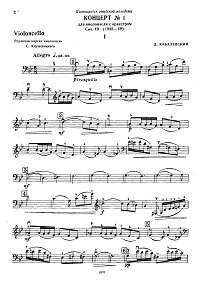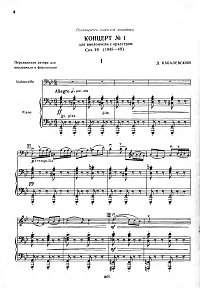Kabalevsky - Cello concerto N1 op.49
Kabalevsky - Cello concerto N1 op.49. You can download the PDF sheet music Kabalevsky - Cello concerto N1 op.49 on this page. Dmitri Kabalevsky wrote his Concerto for Cello and Orchestra in 1948-49. In addition to the work being an important addition to the rather meager literature for the instrument, it is probably the finest of his concerti. It is a melodious work, written with a sensitive understanding of the singing qualities and technical capabilities of the cello. It has immediate appeal and is remarkably tightly written, with subtle ties that bind the themes together. Although it is not based on distinct folk tunes, it imaginatively recaptures the cantilena of Eastern folk music; its melodies grow from little phrases developed in improvisational style, never quite the same on each reappearance. In the same spirit are the changes of time, such as the 6/8 and 9/8 alternation in the first movement. Also reminding one of folk music is the combination of singing cello tones with orchestral woodwinds, a scoring device that also successfully solves the concerto composer's challenge of balancing the sound.
To download PDF, click the "Download PDF" button below the appropriate sheet music image.
To view the first page of Kabalevsky - Cello concerto N1 op.49 click the music sheet image. |
| PDF format sheet music |
|
|
|
Instrument part: 16 pages. 454 K
|
Piano part: 45 pages. 1685 K
|
 |
 |
|
|
| Download PDF (14.99
€) |
Download PDF (14.99
€) |
|
The first theme, which appears in the cello in G minor over a strumming accompaniment, combines statement and answer. Its bubbling sixteenth-note phrases become an undercurrent of the entire movement. The responding eighth-note phrases, always different, generate all the lyricism to come. The second theme proper is a swinging, lyrical melody in C major, which carries on the unflagging vitality of the movement. The opening measures return, and then the second theme undergoes a rhapsodic transformation and development, the time changing to 2/4 and the tonality hovering between major and minor. The climax of the movement is a brilliant combined recapitulation and coda, ending in double-stops and pizzicati from the cello.
The second movement begins with orchestral chords in B major, but the slow cello arpeggios insist on B minor, and these arpeggios give birth to a haunting melodic line, moving between major and minor and answered by soft orchestral phrases, improvisational in feeling and reaching a climax in a cadenza.
The last movement is a free rondo based on a dance theme, which also is never quite the same on each reappearance. Interspersed phrases recall the slow movement arpeggios.
|
|